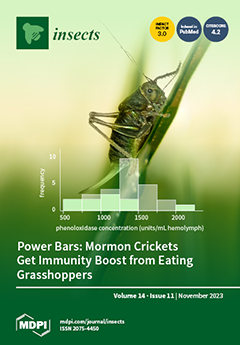Maternally inherited obligate endosymbionts codiverge with their invertebrate hosts and reflect their host’s evolutionary history. Whiteflies (Hemiptera: Aleyrodidae) harbor one obligate endosymbiont,
Candidatus Portiera aleyrodidarum (hereafter
Portiera).
Portiera was anciently acquired by whitefly and has been coevolving with its host ever since.
[...] Read more.
Maternally inherited obligate endosymbionts codiverge with their invertebrate hosts and reflect their host’s evolutionary history. Whiteflies (Hemiptera: Aleyrodidae) harbor one obligate endosymbiont,
Candidatus Portiera aleyrodidarum (hereafter
Portiera).
Portiera was anciently acquired by whitefly and has been coevolving with its host ever since. Uncovering the divergence of endosymbionts provides a fundamental basis for inspecting the coevolutionary processes between the bacteria and their hosts. To illustrate the divergence of
Portiera lineages across different whitefly species, we sequenced the
Portiera genome from
Aleyrodes shizuokensis and conducted a comparative analysis on the basic features and gene evolution with bacterial genomes from five whitefly genera, namely
Aleurodicus,
Aleyrodes,
Bemisia,
Pealius, and
Trialeurodes. The results indicated that
Portiera from
Bemisia possessed significantly larger genomes, fewer coding sequences (CDSs), and a lower coding density. Their gene arrangement differed notably from those of other genera. The phylogeny of the nine
Portiera lineages resembled that of their hosts. Moreover, the lineages were classified into three distinct genetic groups based on the genetic distance, one from
Aleurodicus (Aleurodicinae), one from
Bemisia (Aleyrodinae), and another from
Aleyrodes,
Pealius, and
Trialeurrodes (Aleyrodinae). Synonymous and nonsynonymous rate analyses, parity rule 2 plot analyses, neutrality plot analyses, and effective number of codons analyses supported the distinction of the three genetic groups. Our results indicated that
Portiera from distant hosts exhibit distinct genomic contents, implying codivergence between hosts and their endosymbionts. This work will enhance our understanding of coevolution between hosts and their endosymbionts.
Full article






